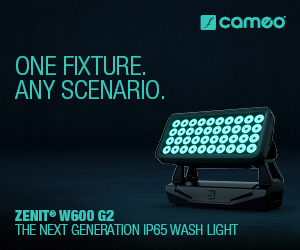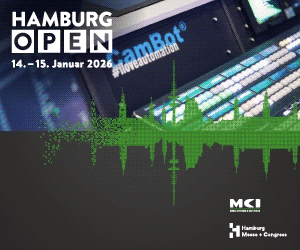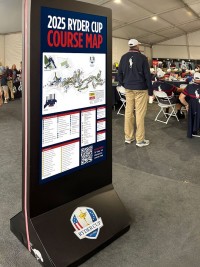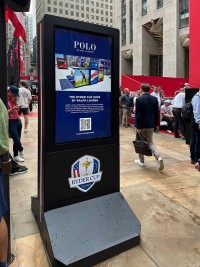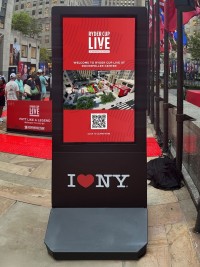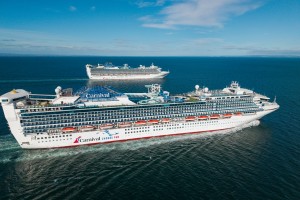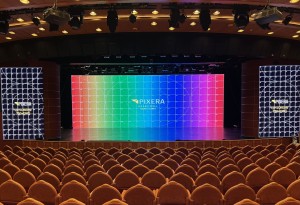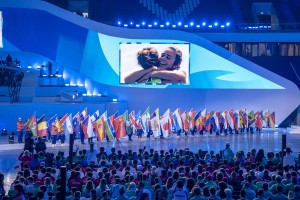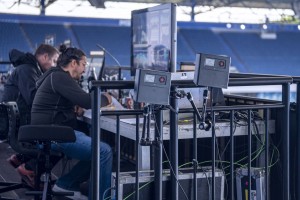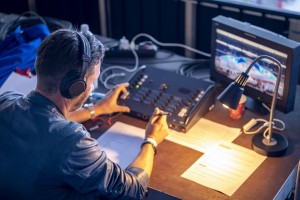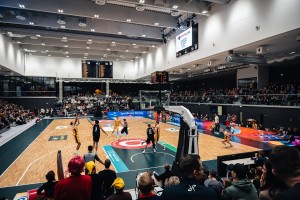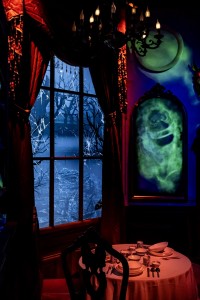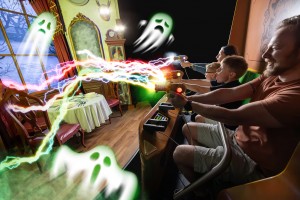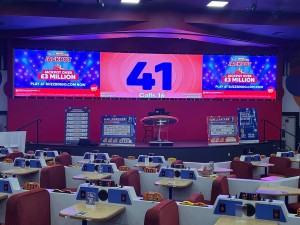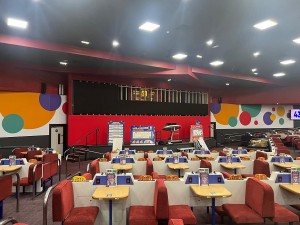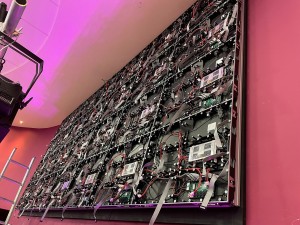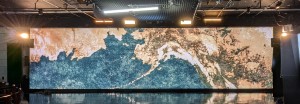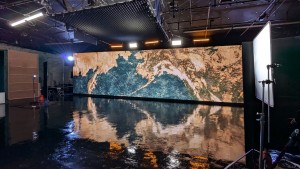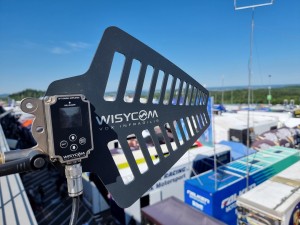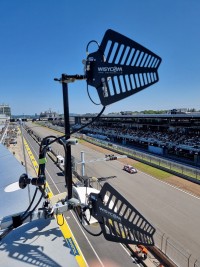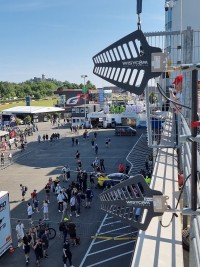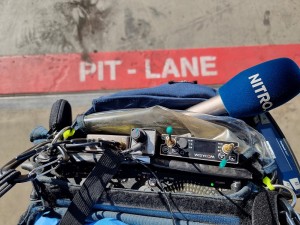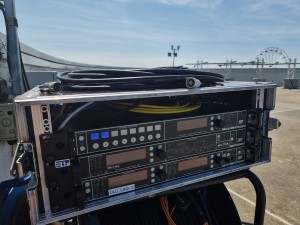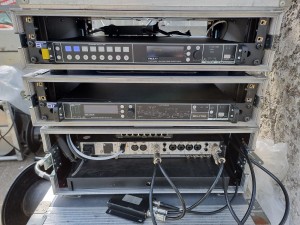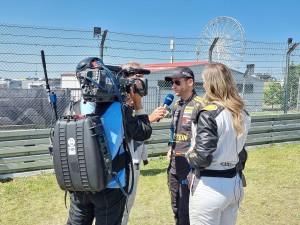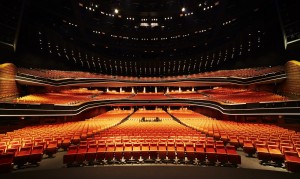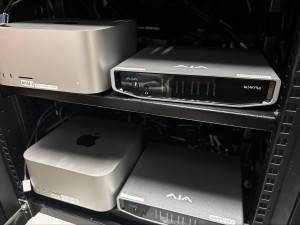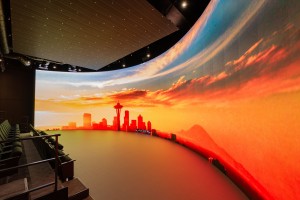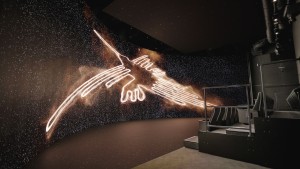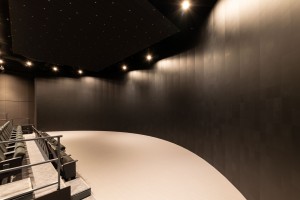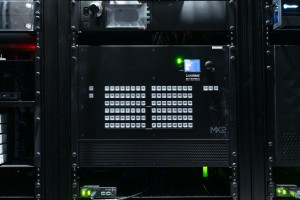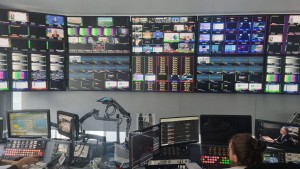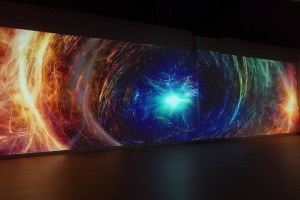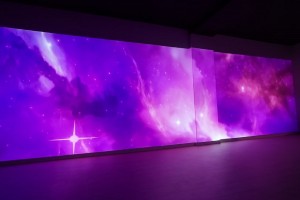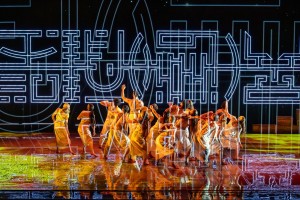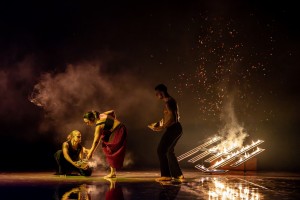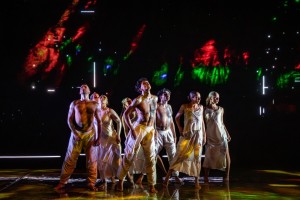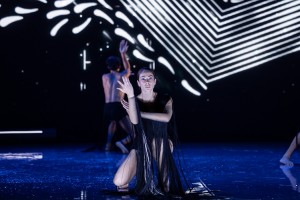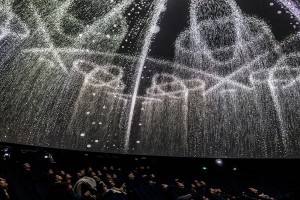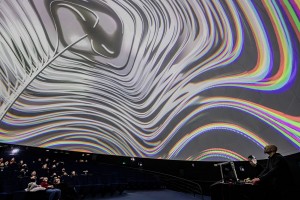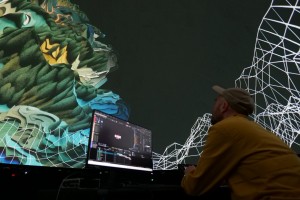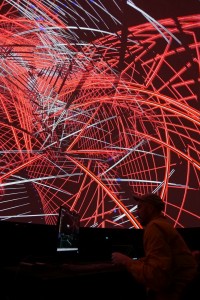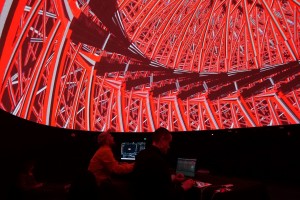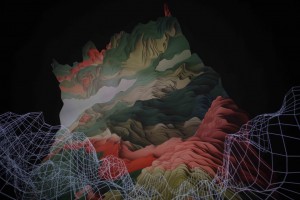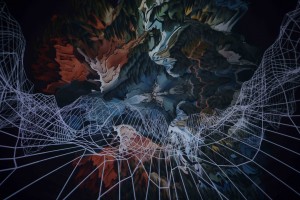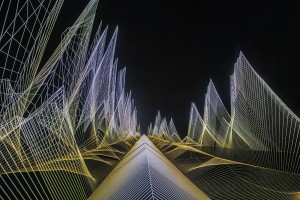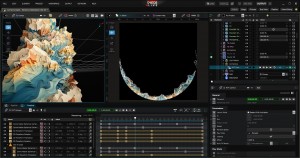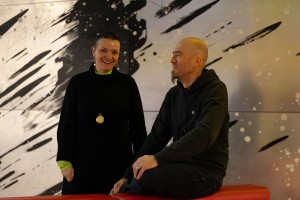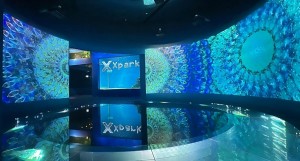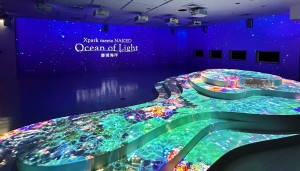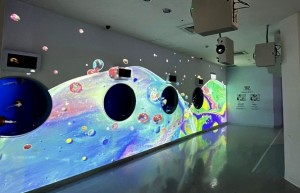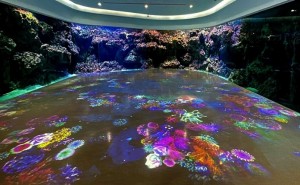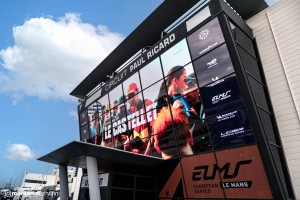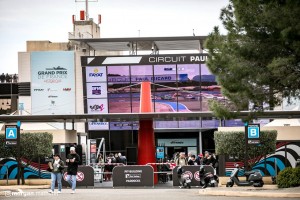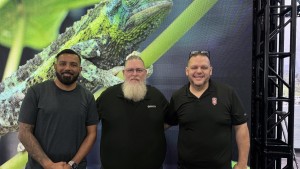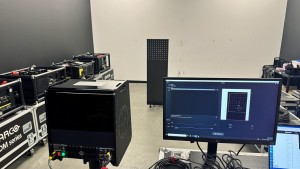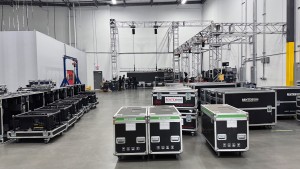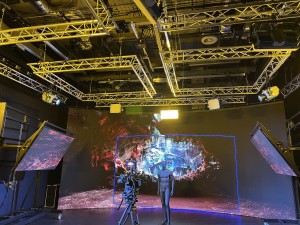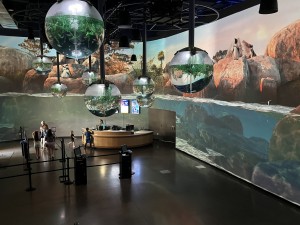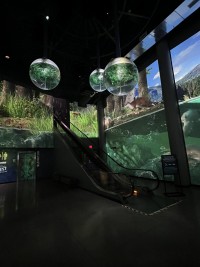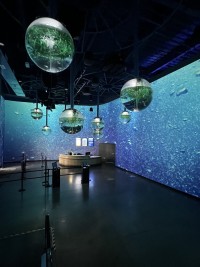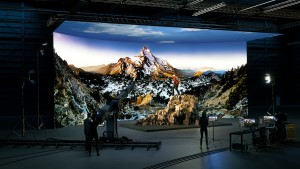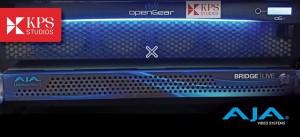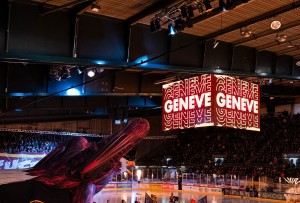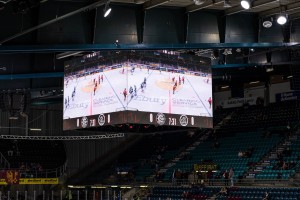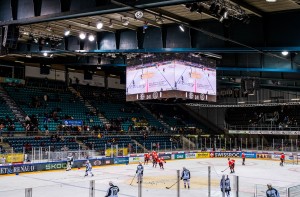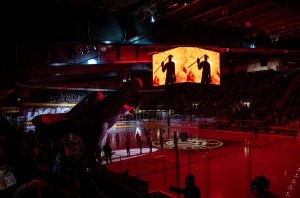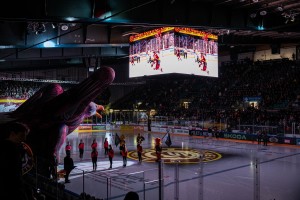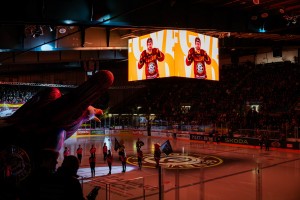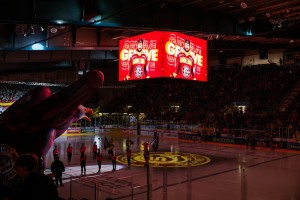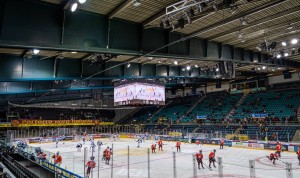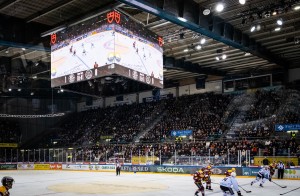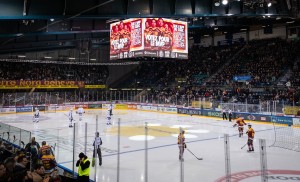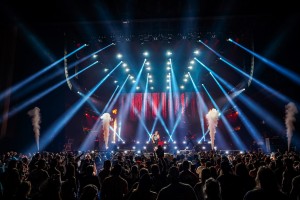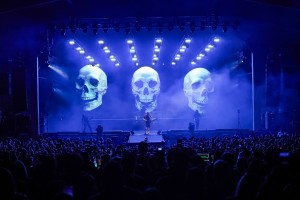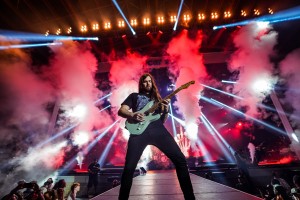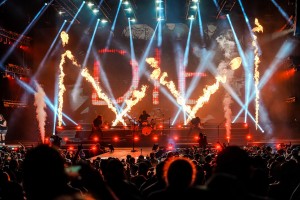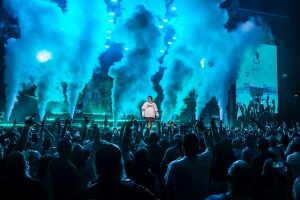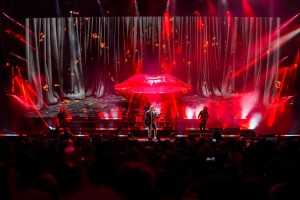AV-Medientechnik News
AV-Medientechnik News Schlagzeilen
Carnival Cruise Line bringt Pixera an Bord
07/10/2025
BES helps The Star Theatre in Singapore modernize video ingest workflow with AJA and ToolsOnAir
13/08/2025
Manganelli stattet Auditorien in Rennes mit Projektionstechnologie von Digital Projection aus
23/06/2025
Ryder Cup nutzt BIG-Digital-Kioske mit BrightSign-Playern
Der Ryder Cup ist das größte Mannschaftsevent im professionellen Herrengolf. Teams aus den USA und Europa treten vor über 200.000 Fans an drei Tagen gegeneinander an. Die Ausgabe 2025 fand im September auf dem Bethpage Black Course in Long Island, New York, statt.
Bisher wurden große LED-Videowände verwendet, um alle Ergebnisse, Faninformationen und Live-Übertragungen anzuzeigen. Es gab jedoch nur begrenzte interaktive Lösungen für Fans, die eine angemessene Höhe und Augenhöhe boten, um wichtige Informationen klar und zugänglich im Freien darzustellen.
Das Netzwerk tragbarer, doppelseitiger BIG-Digital-Kioske - ausgestattet mit Digital-Signage-Media-Playern von BrightSign - nutzte nun API-Integrationen mit der PGA of America, um Live-Ergebnisse, Abschlagszeiten/Paarungen und Spielerstandorte bereitzustellen. Jeder Kiosk verfügte über interaktive Elemente und QR-Codes zum Herunterladen von Inhalten, einschließlich der offiziellen Ryder Cup Mobile App.
Die Kioske boten den Zuschauern zudem praktische Informationen, etwa die Verbindung zu WLAN-Netzwerken und die Lage von Erste-Hilfe-Stationen, Ausgängen, Hospitality-Bereichen sowie Essens- und Getränkestationen. Zum Einsatz kamen Rolo-Outdoor-Werbetafeln sowie - in der PGA of America Members Lounge - freistehende Ruby-Indoor-4K-Touch-Kioske.
(Fotos: BIG Digital/BrightSign)
Carnival Cruise Line bringt Pixera an Bord
Das Kreuzfahrtunternehmen Carnival Cruise Line nutzt die Medienserverplattform Pixera von AV Stumpfl, um visuelle Inhalte in den Entertainment-Bereichen an Bord zu steuern. Vier der insgesamt 29 Carnival-Schiffe nutzen bereits Pixera, weitere sollen in den kommenden Monaten folgen, als Teil einer Strategie, die Video- und Show-Control-Infrastruktur der Reederei zu modernisieren und zukunftssicher zu machen.
Zu den vier Schiffen, die mit Pixera ausgestattet sind, gehören auch die neuesten Flottenmitglieder, die „Carnival Encounter“ und die „Carnival Adventure“, die im März 2025 ihre Jungfernfahrten ab Brisbane bzw. Sydney absolvierten. Auf den modernisierten Schiffen erleben Gäste Pixera in unterschiedlichen Entertainment-Bereichen, von den Haupttheatern und Lounges bis hin zu kleineren Venues wie Comedy-Clubs.
Nach langjähriger Erfahrung mit anderen Media-Servern sei für Carnival unter anderem der Hardware-unabhängige Ansatz von Pixera ausschlaggebend gewesen. „Pixera gibt uns die Flexibilität, unsere speziell angefertigten Server zu nutzen, was für unseren Workflow essenziell ist“, erklärt Grant Kruger, Entertainment Technical Fleet Supervisor - Lighting bei Carnival Cruise Line. „Wir betreuen den gesamten technischen Betrieb auf 29 Kreuzfahrtschiffen intern, von der Wartung der Fixtures bis hin zu den Media-Servern.“
Die Pixera-Software erfülle auch die Anforderungen der Reederei in Bezug auf fortschrittliches Tracking und Automation, so Kruger. Von besonderer Bedeutung sei dabei die nahtlose Integration mit wichtigen Drittanbieter-Protokollen: „Es gibt nicht viele Media-Server, die sowohl PSN (PosiStageNet) als auch Notch unterstützen. Unsere Automationssysteme senden PSN-Daten an die Media-Server - wir brauchen also Echtzeit-Tracking, und Pixera liefert das.“
Mittels Show-Management- und Timeline-Tools von Pixera könne das Carnival-Team zudem Projektordner von einem Schiff auf das nächste übertragen und mit geringem Programmieraufwand anpassen. Lichtdesigner und -programmierer des Upgrade-Projekts ist David Horner von VC Live Ltd.
(Foto: Carnival Cruise Line)
Riedel liefert Kommunikations- und Netzwerkinfrastruktur für FISU Games
Riedel Communications war offizieller Partner der FISU World University Games 2025 im Rhein-Ruhr-Gebiet und lieferte Managed-Technology-Service, der die Kommunikations- und Netzwerkinfrastruktur für alle Veranstaltungsorte und das International Broadcast Center (IBC) umfasste.
Das Riedel-Team sorgte für Konnektivität und Koordination bei einem der größten Multisport-Events des Jahres, einschließlich der Eröffnungs- und Abschlusszeremonien. Die in mehreren Städten der Rhein-Ruhr-Region ausgetragenen Spiele erforderten ein skalierbares Backbone-Netzwerk, um reibungslose Produktionsabläufe in 23 Sportstätten und der IBC in Essen zu ermöglichen. Riedels Managed-Technology-Team lieferte Internetkonnektivität, Intercom- und Funksysteme sowie Remote-Monitoring und operative Unterstützung.
„Unser Team hat eine Netzwerkinfrastruktur mit rund 53 Kilometern temporärer Multicore-Glasfaserkabel eingerichtet, die alle Veranstaltungsorte über ein zentrales Glasfasernetz miteinander verbanden“, erklärt Lukas Stellmacher, Senior Project Manager bei Riedel Communications. „Im IBC haben wir ein spezielles Network Operation Center (NOC) eingerichtet, in dem Experten alle Systeme in Echtzeit überwachen und verwalten konnten.“ Binnen acht Wochen sei das gesamte Netzwerk implementiert worden.
Im Zentrum stand ein kollaboratives Kommunikationssystem, in dem Riedel-Technologien eine Schlüsselrolle spielten. An allen Veranstaltungsorten und im IBC wurden Artist-Intercom-Systeme, Bolero-Beltpacks, SmartPanels und MediorNet-Nodes vom Riedel-Team und anderen Gewerken der Broadcast- und Eventproduktion eingesetzt. Für bestimmte Wettbewerbe wurde auch Riedels Bolero-S-RefComms-System im agilen Standalone-Modus implementiert, um klare Kommunikation zwischen den Schiedsrichtern zu gewährleisten. Die Systeme wurden nahtlos in ein einheitliches Netzwerk eingebunden, das verschiedene Produktionsbereiche verknüpfte.
Für die Produktionskommunikation wurden 2.000 Motorola-MXP600-Funkgeräte in einem Tetra-Netzwerk mit zwanzig DAMM- und Motorola-Systemen eingesetzt. Diese Konfiguration unterstützte 300 Funkgruppen in 28 Zonen und ermöglichte zuverlässige Kommunikation für Mitarbeiter und Sicherheitspersonal. Riedels Juggler-Technologie verband die Tetra-Funkgeräte, Bolero-Drahtlos-Intercoms und Artist-Intercom-Systeme zu einer interoperablen Plattform.
Darüber hinaus verantwortete das Riedel-Team umfassende IT-Dienstleistungen. Ein zentrales IT-Netzwerk verband alle Standorte und unterstützte Intercom, Internet-Access-Points sowie spezielle Anwendungen wie Audiodeskription, die zentral aus dem IBC ferngesteuert und überwacht wurden. Das Team stellte außerdem 450 Laptops, fünfzig Tablets und 130 vernetzte Multifunktionsdrucker in allen Betriebsbereichen bereit, welche die technologische Grundlage für logistische und administrative Arbeitsabläufe bildeten.
(Fotos: Riedel Communications)
Ledcon wird Partner der 2. Basketball-Bundesliga
Die 2. Basketball-Bundesliga und die Ledcon Systems GmbH haben eine langfristige Partnerschaft geschlossen. Der Spezialist für LED-Videotechnik mit Sitz in Rheine wird die Liga künftig als offizieller Partner unterstützen.
„Mit Ledcon gewinnen wir einen Partner, der perfekt zu unserer Liga passt“, sagt Christian Krings, Geschäftsführer der 2. Basketball-Bundesliga. „Moderne Bild- und Präsentationstechnik ist ein wesentlicher Bestandteil des Sporterlebnisses und steigert die Attraktivität für Fans und Partner gleichermaßen.“
„Basketball steht für Dynamik, Schnelligkeit und Emotion - genau das möchten wir mit unseren LED-Lösungen sichtbar machen“, ergänzt Udo Bloms, Geschäftsführer, Ledcon. „Gemeinsam wollen wir die mediale Strahlkraft des Basketballs weiter stärken.“
(Foto: Felix Krueppel)
Christie GS Series projectors power Ghostly Manor attraction at Paultons Park
Christie 1DLP laser projectors are delivering immersive visuals at Ghostly Manor, a new dark ride at Paultons Park in Hampshire, UK. Designed and installed by Lagotronics Projects, the £3.5 million attraction combines physical sets, projection mapping, and interactive gameplay to create a thrilling ghost-themed adventure. Six Christie DWU1100-GS and two DWU1400-GS laser projectors bring the haunted scenes to life.
Ghostly Manor uses a new ride format, Gameplay Theater, created by Mack Rides and Lagotronics Projects. Continuously rotating vehicles, each seating eight passengers back-to-back, reveal new environments with each turn. Guests are equipped with Phantom Phasers, onboard interactive “blasters” that allow them to capture ghosts across eight unique scenes. The format allows for high guest throughput in a small circular footprint to maximise efficiency and reduce queuing, and the ride concludes with a score scene displaying guest performance and photos.
With the vehicles located close to the screen, the team had to install projectors from a high angle to avoid casting shadows from the players, while avoiding warping and blending artifacts. Christie provided technical support, and 0.37-0.4:1 ultra short throw lenses were used with each projector to achieve the desired result, projecting onto surfaces approximately 10 m wide by 3.5 m high (32 ft by 11.5 ft). The ride was built on the site of a former 4D theatre.
(Photos: Lagotronics Projects/Paultons Park)
Unicol mounts support major video wall installation across UK Bingo sites
Unicol Engineering, a provider of audio-visual mounting solutions, has supported a major nationwide LED video wall installation across multiple bingo sites throughout the UK. The project, delivered by AV integrator Willow Communications, saw Unicol’s Spirit dvLED Video Wall Mounts installed at venues operated by Mecca Bingo, Buzz Bingo, Club3000 and Deluxe Bingo in locations including Leeds, Northampton, Sheffield, Ipswich, Broadstairs and Wakefield.
The installations feature a variety of LED video wall configurations, ranging from compact 2,560 x 1,440 mm displays to expansive 12,000 x 2,000 mm installations. With configurations from 4 x 3 panel arrays up to substantial 24 x 4 arrays, all utilised Hisense’s XIM, XIH and RNM ranges of dvLED panels.
Unicol’s Spirit dvLED Video Wall Mount proved essential in accommodating the diverse requirements across the various venues. The mounting system’s built-in adjustment capabilities, providing 20 mm of movement both horizontally and vertically through its wall-tie bracket design, meant installers could work with different wall types and overcome on-site challenges. Over 410,000 metres of Unicol’s 40x40 aluminium extrusion was used across the installations.
Willow Communications drew on over 35 years of experience in AV installations to deliver the complex multi-site rollout within tight timeframes, all while minimising disruption to venue operations. “The final result looks great. It’s clean, sharp, and just works”, states James Pearson, Project Manager at Willow Communications. “It was a solid team effort between us, Hisense, and Unicol.”
(Photos: Unicol Engineering)
Brompton Technology empowers S4 Studios’ virtual production workflow for Discovery’s “Expedition Files”
S4 Studios, a creative design and production studio specialising in Virtual Production, Visual FX and Motion Graphics, has partnered with Brompton Technology to deliver a virtual production workflow for Ping Pong Productions’ “Expedition Files”, a new series from the Discovery Channel. With the support of Brompton Technology’s Tessera LED video processors, S4 Studios achieved an ambitious production pace, completing up to 25 shots per day, while maintaining real time control across their LED stage.
Filmed at Brandon Studios in Burbank, California, “Expedition Files” follows host Josh Gates as he investigates historical enigmas and unsolved mysteries from around the world. The shoot required constant environment changes, rapid turnaround, and seamless coordination between physical and virtual elements, a perfect challenge for S4 Studios’ real time production pipeline.
“On most shoots, LED processors only control brightness and color temp”, explains Geoffrey Kater, Owner and Senior Creative Director at S4 Studios. “Brompton’s color science gives us more - input switching, NIT levels, ShutterSync, phase, fade-to-black, freeze functions, all mapped to a Stream Deck for real-time changes. That kind of flexibility became a vital part of our on-set workflow.”
The S4 Studios’ production team includes Lead Unreal Engineer Macario Alvarez, a seasoned developer with years of experience across top-tier game studios, and Supervising Engineer Ben Betts, a specialist in LED wall systems with more than thirty years of on-set playback engineering for motion pictures. Together, they support a creative-to-delivery pipeline for film, television, and commercial content. “None of this could have been achieved without the creative team at Ping Pong Productions that brought this project to S4 and had the vision to utilize complex Virtual Production technology for this show”, says Kater.
The studio’s client portfolio includes Discovery Channel, History Channel, EA Sports, Paramount, Warner Brothers, BBC Worldwide, NBC Universal, Walt Disney Television, Lionsgate, PlayStation, along with a wide range of advertising agencies and music labels.
For “Expedition Files”, S4 Studios deployed Assimilate Live FX instead of Unreal Engine, opting for layered 2.5D environments with camera tracking to maximize speed and responsiveness. The LED volume, featuring ROE Visual BPv2 (Black Pearl) panels and driven by Brompton’s 4K Tessera SX40 LED video processors, enabled fast setup changes without sacrificing creative flexibility.
“This show required us to move fast, with six or more setups per day, for up to 25 shots”, explains Kater. “There’s no room for technical downtime. With Brompton, we could instantly shift between setups, freeze frames using Frame Store, adjust brightness, color temperature, LUTs, mapping or switch inputs with zero disruption. It’s a game-changer.”
Brompton’s SDI/HDMI multiple input capabilities also played a key role. “We had one system running Live FX with camera tracking and another for standalone video playback”, says Kater. “With Brompton, we could prep new scenes on a second machine, and switch inputs instantly when ready, with no repatching and no lag.” Working closely with their stage partner Brandon Studios, who invested in Brompton Tessera hardware, S4 Studios built a custom Stream Deck interface for managing the processors during live shoots.
“We created layouts that let our engineers control the processors directly, switching sources, toggling profiles, applying screen effects, all at the push of a button”, continues Kater. “We also built profiles for different setups within the Tessera software, so loading a new scene was just one click. That kind of repeatability is massive when you are doing shot after shot.”
This level of real-time responsiveness allowed S4 to choreograph entire scenes, from Arctic shipwrecks and jungle expeditions to the fog-filled streets of 19th-century London, using physical props, layered media, and camera tracking.
(Photos: Brompton Technology/S4 Studios)
TV Skyline chooses Wisycom for ADAC 24-Hour Race
TV Skyline, one of Germany’s leading broadcast providers, supports a wide range of productions across Europe and beyond. From Bundesliga and Champions League matches to large-scale entertainment and music events, the company is experienced in complex live broadcasting. For many years, TV Skyline has helped deliver broadcast coverage at the ADAC 24-Hour Race at the Nürburgring. Renowned for its technical challenges and vast terrain, the event requires a robust and highly flexible RF system.
The historic ADAC 24-Hour Race at Nürburgring is one of the world’s most legendary racing events. Starting in the afternoon on a Saturday and concluding 24 hours later, the annual endurance race garnered around 300,000 attendees on-site this year alone. The track, reaching almost 22 kilometers long with nearly 300 meters in elevation change, holds around 120 cars in participation - ranging from amateur to major teams - all sharing about thirty pit spaces. “It’s a logistical beast”, says Daniel Jäger, Sound Engineer, TV Skyline. With unpredictable weather, dense crowds and a tight race environment, the Nürburgring presented significant RF and operational hurdles. “It’s more like a motorsport festival”, says Alexander Wenke, TV Skyline’s OB Truck Manager. “For 24 hours, the drivers and crew need to perform without fail.”
TV Skyline brought two OB vans to the site: one to handle the international feed and another for national coverage in Germany. The main OB van managed approximately seventy cameras stationed along the track, with about 100 microphones capturing audio. Given the size of the area, a conventional wireless setup wasn’t an option. “That’s why Wisycom’s fiber-based RF solutions were essential”, says Jäger. “It allowed us to connect multiple antennas across vast distances and operate as if it’s one big RF zone. Otherwise, we would have needed individual receivers everywhere, which is not efficient.”
The company deployed Wisycom’s MFL fiber links, MRK980 receivers, MTK952 transmitters, MTH400 handhelds, MPR30 IEM belt packs and RPU500 portable transmitters. For camera receivers, they used MCR42 and MCR54 units, providing a backup layer to ensure audio integrity. “Each of the two camera presenters had a sound technician, who each mixed their respective presenter and guest microphones on location and sent it to the OB van via RPU500. This eliminated latency and ensured the talent could hear themselves, which is crucial in the noisy pit lane”, Jäger explains. “While this could be made easier by just using the back-up receivers on the radio cameras, the moderators would not be able to hear themselves due to the latency.” Wisycom’s ISO frequency technology was also critical. “It let us transmit the same frequency across multiple antennas, so our talent can roam freely without losing signal or needing to switch packs”, adds Jäger. “It was seamless.”
The Nürburgring environment is notoriously hostile to wireless systems. The pit lane alone spans nearly 400 meters, with concrete and metal structures throughout the facility, all while dozens of teams run their own RF gear with no official coordination. “There’s no clear RF spectrum”, says Jäger. “Some amateur teams bring outdated or unregulated gear, and the environment changes daily. What worked Tuesday might be unusable by Thursday. Wisycom handles it with resilience and headroom.”
Despite the scale and complexity, the TV Skyline crew, including eighteen engineers on-site, deployed the system with precision. “We have it down to a process now”, says Stefan Thenmayer, Head of Audio at TV Skyline and A1 for the race. “We use Google Maps to plan antenna placements, coordinate what’s needed with the team and adapt to whatever the broadcast station requires. The system is versatile enough to work over both fiber and RF cable, which makes setup much easier.”
(Photos: Wisycom)
BES helps The Star Theatre in Singapore modernize video ingest workflow with AJA and ToolsOnAir
Systems integrator Broadcast Engineering Services (BES) has upgraded the legacy video ingest system at The Star Theatre/The Star Performing Arts Centre in Singapore with a new HD and 4K recording pipeline, comprising AJA Video Systems’ Io 4K Plus and Io X3 I/O devices integrated with ToolsOnAir’s Just:in mac multi-channel video recording software.
“The Star came to us looking to revamp its HD recording pipeline, but with support for 4K, as it anticipates future client demand for higher resolution files”, explains BES Project Director Brian Li Chuan. “Having deployed AJA’s I/O devices and Just:in Mac across other installs, we knew the combination would suit their needs. Beyond meeting their technical specifications, the setup was attractive to their team because it would allow them to ingest multiple HD and 4K ingest sources using a Mac Studio.”
The technology deployed across productions at The Star varies depending on the artist, group, or event. With fifteen cameras in-house, the venue AV team typically leverages anywhere from two to all fifteen cameras and a switcher for each event, from which HD signals are sent through to Io X3 devices and ingested into Just:in Mac for recording. Occasionally, clients bring their own cameras and ancillary equipment, in which case, the signals are patched into the theatre control room and similarly fed through an Io X3 and recorded via Just:in Mac. If a client requests 4K, The Star can ingest signals through its Io 4K Plus units. After each event wraps, its team hands over the files to the client, so they can use the recordings however they see fit.
“Having a single interface powered by AJA I/O gear and Just:in Mac, where The Star’s AV team can manage multiple concurrent camera recordings, has been a game changer”, says Li Chuan. “It’s now easier for one team member to stop, start, and pause recordings from one central interface, whereas before the team had to switch between multiple PCs to do each recording. With Just:in Mac, The Star’s AV team can also listen to audio feeds coming through the recording system from different sources to ensure everything is in sync. The Io X3 and Io 4K Plus also make it easy to select and assign various recording profiles across sources, including MP4, Apple ProRes, and more.”
Anticipating what comes next, BES and The Star are exploring how the facility might transition from baseband video to SMPTE 2110 in the future.
(Photos: AJA Video Systems/BES)
Lightware reimagines Japan’s Xross Theater with advanced video distribution technology
Lightware’s MX2-48X48-HDMI20-A-R matrix switcher has become a pivotal component in bringing the Koishikawa Xross Digital Museum to life. This immersive theater - located at Toppan Koishikawa in Bunkyo, Tokyo, Japan - is designed to transport visitors into 360° environments, with the use of ultra-high-resolution displays and next-generation AV integration, made possible through a collaboration between For-A Co., Ltd., MTC Japan and Lightware Visual Engineering.
The theater boasts a 16K Crystal LED screen, along with a Leyard ceiling LED screen and an LED floor screen, designed to fully immerse audiences. Toppan required a system that could support HDMI 2.0 distribution across a 64x64 matrix, providing seamless 4K 60P RGB 4:4:4 video quality. As there were no domestic manufacturers that offered a 64x64 HDMI matrix that supported 18 Gbps with non-blocking and met RGB 4:4:4 specifications, MTC Japan, the project’s AV integration partner, turned to Lightware.
“We needed a high-capacity solution that could handle the 18 Gbps data stream efficiently, and Lightware’s MX2-48X48-HDMI20-A-R was the only matrix switcher capable of meeting these requirements”, says MTC’s Junji Matsuoka. “The high-level video distribution capability of the MX2 was a game changer. In addition to offering a 64x64 HDMI 2.0 matrix, the MX2’s seamless integration with control systems through Lightware’s LW2 protocol simplified what could have been an intricate setup.”
At the heart of Xross Theater’s AV system is a PC server developed by Toppan that outputs eight signals, all routed through Lightware’s matrix to the video wall processor. On the output side, the MX2-48X48-HDMI20-A-R distributes signals to the RGBlink X8 processor with 24 inputs, which handle the 16K projections on the Crystal LED screen.
“The biggest challenge was coordinating all the moving parts and ensuring seamless integration”, says Yu Nakamura from Toppan Inc. “Lightware’s MX2 played a key role in overcoming these hurdles. It gave us confidence that the video distribution would be executed, which was crucial for the immersive environment we wanted to create.”
(Photos: Toppan Inc.)
France 24 streamlines remote guest contributions with QuickLink StudioEdge
France 24, the international news and current affairs television network broadcasting in French, English, Arabic and Spanish, has improved its remote guest integration capabilities by deploying QuickLink’s StudioEdge and StudioCall solutions.
As a broadcaster producing content in four languages, France 24 relies heavily on remote contributions for live news and interviews. Faced with mounting challenges and persistent connection issues using traditional video conferencing tools, the team at France 24 sought a more robust solution. With the official retirement of Skype and the phase-out of Skype TX, France 24 turned to QuickLink to modernize its infrastructure and streamline its production guest workflow.
QuickLink’s StudioEdge enables France 24 to seamlessly introduce remote guests via Zoom, Microsoft Teams and QuickLink’s own StudioCall platform, making it an upgrade from solutions that rely on Skype TX. With StudioEdge, the video and audio quality of remote guests/callers can be optimized using AI-technology powered by Nvidia, ensuring broadcast-quality results with minimal operator intervention.
“StudioEdge resolved a lot of the issues we often encountered using Skype TX”, says Eric Devoisin-Lagarde, Traffic & External Production Resources Manager at France 24. “Today, while we initially planned to integrate StudioEdge gradually, the majority of our connections are already being made through the platform.”
Initially, a single StudioEdge server was deployed into France 24’s production infrastructure to support all three channels produced in Paris. Two additional servers have since been integrated, providing a dedicated server for each language-specific channel. “Having dedicated servers for each language allows for increased flexibility and reduces any potential bottlenecks during simultaneous live broadcasts”, explains Devoisin-Lagarde. France 24 Colombia will also integrate the StudioEdge solution.
France 24’s guest coordination team manages bookings, tests connectivity and ensures video quality prior to live appearances. Links for guest participation - whether via Teams, Zoom or StudioCall - are managed within its internal media operations platform, which interfaces directly with the Master Control Room.
In addition to StudioEdge, France 24 has also seen significant benefits from QuickLink StudioCall, one of the available supported platforms within StudioEdge. This solution enables operators to connect remote guests using nothing more than a web browser. Invitations can be deployed via email, SMS, WhatsApp or by sharing a direct join link - allowing contributors to connect within seconds. “StudioCall has been a great solution for those who don’t want to use Teams or Zoom”, says Devoisin-Lagarde.
Additionally, Zoom integration within StudioEdge further streamlines workflows by allowing France 24’s production team to generate meeting links directly from the web-based interface. With the full three-server deployment, France 24 has experienced enhanced reliability and scalability for its multilingual programming.
(Photo: France 24/QuickLink)
Immersive yoga experience in Switzerland powered by Christie projection
Casa Boost, a wellness studio in Geneva, Switzerland, is transforming yoga into an immersive experience using Christie Captiva DWU500S ultra-short throw laser projectors. The installation, carried out by Moonlight Drive in partnership with The Good Brand, turns a wall into a dynamic visual canvas that enhances meditation and movement sessions with vivid projections of landscapes, galaxies, and flowing textures.
Casa Boost is a space where light, sound, and movement converge to inspire physical and mental transformation. To elevate this concept, the studio wanted to break away from traditional yoga class formats and create a space where projection would support the emotional journey of each session.
The narrow, elongated room with minimal projection distance and architectural obstacles posed a challenge, though. “The only way to fully cover the projection area without compromising on focus or brightness was with Christie Captiva”, says Luis Guadalajara, Director at Moonlight Drive. “Their ultra-short throw capability was key in avoiding shadows during classes, even when the room is full.”
Two Captiva DWU500S projectors, featuring 1DLP laser technology and WUXGA resolution (1920 x 1200), were installed side by side to create a seamless blend over a 9-meter-wide by 2.2-meter-high (30-foot-wide by 7-feet-high) wall, which serves as the projection surface. Painted in a neutral gray tone to maximize color vibrancy, the wall displays looped video content tailored to each class, from tranquil natural scenes to animated cosmic journeys.
The Captiva projectors are equipped with ultra-short throw lenses (0.25:1) and offer 5000 lumens of brightness. Their laser illumination system provides up to 20,000 hours of operation with minimal maintenance, while built-in edge blending and warping capabilities help overcome structural challenges in the room. The immersive visuals, delivered in 3840 x 1200 resolution, blend with the session’s rhythm.
“Everything was planned remotely, based on measurements and 3D simulations”, says Guadalajara. “We arrived with everything ready and executed in one day.” The Christie Captiva projectors were supplied by Christie partner Charmex, and the project was initiated with help from The Good Brand, which connected Casa Boost with Moonlight Drive. The integration included not only the projection system, but also a content server with two outputs, ambient audio, and automated scheduling aligned with class routines.
(Photos: Christie Digital Systems/Casa Boost)
Electric Forest festival ramps up content with Green Hippo’s Hippotizer Media Servers
Visual solutions company Observatory created new content for this year’s multi-genre Electric Forest festival at the Double JJ Resort in Rothbury, Michigan, using two Hippotizer Boreal+ MK2 Media Servers driving two 4k outputs each to deliver the spectacle.
Simon Harris and his team at Observatory were commissioned by Leisure Expert Group - the Creative Directors of Insomniac who part own the festival - to create two new pieces of scenic content for the Sherwood Stage. Deploying the Boreal+ MK2s, which were supplied by Screenworks, the Observatory team delivered control equipment, programming, operation and content for the festival, as well as scenic content.
On stage the team rigged a 5 mm LED proscenium “header”, two IMAG screen and upstage LED at 7 mm, with a full canvas size of 7056 x 2864. These displayed the bespoke content, live camera feed and artist-supplied VJ content, which was operated by Harris when there was no guest VJ. “The Boreal+ MK2s did a fantastic job of maintaining smooth playback of content across the huge LED canvas”, he says. “On one occasion, I received guest content very late, but was able to download and transcode 20 GB of content in a 45-minute changeover. It was also then sync’d to the backup via the 10 GB network card in minutes, which was all made possible by Hippotizer’s Media Manager, and a very fast FOH internet connection.”
Harris notes that on some occasions it was necessary to playback scenic content on the proscenium LED while also busking VJ content on the Upstage LED wall, which was all achieved from a single Hippotizer Boreal+ MK2. The control equipment working in tandem with the Hippotizers included a Traktor F1 MIDI controller, Custom Touch OSC app running on an Apple iPad Pro, and a FaderDox UC 4 MIDI controller.
“The standout moment for me this year was the two new scenic clips we created for the show”, Harris continues. “We recently updated our workflow to .exr, allowing us to process multiple passes efficiently and to process our content in 32-bit, giving us more color information, improving color depth and gradients in our rendering pipeline. Using multiple passes within the same render allows us to separate elements of the content into different layers that give the impression of controlling lighting in realtime.”
“The scene is rendered in layers, separating the background, light sources and light rays, to allow me as an operator to playback both clips in sync, and adjust lighting colors to match or compliment the guest VJ/LD looks on stage”, he furthers. “I also used Hippotizer’s X-Fade engine to transition between colors to keep everything looking seamless. It’s an efficient way of creating more flexible content, which would otherwise only have been possible using a realtime render engine such as TouchDesigner or Unreal Engine.”
Helping to deliver the festival were Sherwood Court Stage Manager Kat Harris, Sherwood Court Lighting Director Tiberious Benson, Sherwood Court Video Engineer Derek Glover from NEP Screenworks, and Electric Forest Video Production Manager Jeff Smith at NEP Screenworks.
ROE Visual LED screen on tour with Bangarra Dance Theatre
Bangarra Dance Theatre, one of Australia’s leading performing arts companies, used ROE Visual’s Carbon CB5 for their “Illume” production to achieve immersive creative effects. Novatech Creative Event Technology supplied the complete LED setup for this production, which is the first theatre-based production for Bangarra to choose an LED wall over traditional backdrops.
As this is Bangarra’s first collaboration with First Nations visual artist Darrell Sibosado, “Illume” created a multidimensional narrative rooted in Indigenous cultural storytelling. It explored the awe of light and how it serves as a bridge between the physical and spiritual worlds, while also addressing the pressing issue of light pollution in the context of the climate emergency.
Playing into the trend of using LED-based solutions to translate creative storytelling and add immersive backgrounds to the theatre stage, the creative team found the Carbon LED wall to be the right medium for their artistic expression, enabling them to achieve visual effects that were previously unattainable. With lighting design by Damien Cooper and video design by Craig Wilkinson, the team approached the project with an open mind, embracing the options of an LED-based backdrop. The creative team wished to blend dance choreography and visual art, as provided by First Nations stories, and the overall effect resulted in diverse and distinct layers, adding visual depth as on-stage elements merged with the digital backdrop.
The “Illume” performance marks the first occasion on which Bangarra incorporated LED into their performances. “The LED screen could cover everything we needed artistically, bringing even more ideas to life”, says Production Manager Cat Studley. “It was the best way to go.” Frances Rings, Director and Choreographer of “Illume”, adds: “The screen gave an otherworldly glow and helped create a world that was timeless. I loved that it was very futuristic and allowed us to explore a totally new way of telling our stories at Bangarra.”
“Illume” is currently touring Australia from June to September, enabling a broader audience to experience Bangarra/First Nations history, perspectives, and worldviews.
(Photos: Daniel Boud)
Immersive fulldome show “Sensitive Abstraction” created with Smode
Smode, Smode Tech’s media server and real-time compositing platform, is powering “Sensitive Abstraction”, a new fulldome graphic and sound art performance by visual artist Yannick Moréteau and electronic music composer Flore.
Described as an immersive journey through the poetic dimensions of mathematics, “Sensitive Abstraction” has been touring planetaria and digital arts festivals in Canada and France since its premiere in 2024. Created entirely within Smode, “Sensitive Abstraction” transforms abstract mathematical principles such as the Fibonacci sequence and Euclidean grids into flowing visual tableaux, synchronised in real time with Flore’s score in spatial audio.
Yannick Moréteau, founder of the arts collective WSK, developed and runs the entire performance using a single Smode media server, from the creation of the visuals to generating and exporting the content, previewing the dome projection, and managing the show live with Smode’s real-time compositing capabilities. Unlike traditional media servers without real-time compositing, where all content must be pre-rendered ahead of a show, Smode allows common graphic operations such as moving objects in 3D space, changing their size and appearance and improving colourimetry to be made almost instantaneously. “In a dome, working with real-time generative content is essential”, explains Moréteau. “You need to be able to adjust perspectives on the spot; drawing a straight line in a hemisphere is quite a challenge.”
“Sensitive Abstraction” is delivered to audiences using two synced computers - a desktop for video and a laptop for audio - with video streamed at 4K resolution (ideally 4096 x 4096) via NDI to venue servers for projection. The projection set-up inevitably varies depending on the venue: usually 4-5 projectors are sufficient, although at the large SAT (Société des arts technologiques) auditorium in Montreal - one of several venues visited by the show, along with the planetarium at the Cité des sciences et de l’industrie in Paris and the La Rayonne concert space in Lyon, among others - the show used eight projectors along with 157 loudspeakers.
“The set-up is scalable from one dome to another”, says Moréteau. “We often need to make adjustments depending on the dome’s angle and shape - whether it’s a perfect 180° hemisphere or not.” That’s where Smode served as a tool for live adaptation, avoiding the need for lengthy, heavy re-exports of the video content. “Aside from generating the content, I used Smode to preview the dome projection”, adds Moréteau. “That helped me anticipate what would or wouldn’t work, without needing access to a real dome every time.”
Alongside touring “Sensitive Abstraction”, the WSK collective have also found time over the past year to lead Smode workshops and demos for budding visual designers, so impressed were they with the platform, according to Yannick Moréteau. Smode Tech has provided WSK - of which is it a technical partner - with a Smode Live Premium licence.
(Photos: Jolan Chenot/EPPDCSI/Yannick Moréteau/Arnaud Robin/TheSnDoctor)
Christie ProAV solutions power new digital ocean experience at Xpark Aquarium
Christie’s projection and media playback solutions are powering the new “Xpark meets Naked - Ocean of Light: Immersive Ocean” exhibition at Xpark Aquarium in Taipei. Created by Japan’s creative company Naked, Inc., the exhibition officially opened to the public on June 28, 2025, as part of the aquarium’s fifth anniversary celebrations.
The new attraction fuses real marine life with digital art from the “Naked Ocean” series to create an immersive, multi-sensory journey. Combining oceanic projections, interactive displays, and visual storytelling, the exhibition reimagines the ocean as a living canvas - where nature, creativity, and technology come together to inspire awe and reflection.
Christie’s longstanding partner Dacoms Technology was responsible for the projection design and systems integration for this large-scale attraction. The setup features fifteen Christie 1DLP laser projectors, including Inspire Series DWU960ST-iS fitted with short throw zoom lenses, GS Series DWU880-GS projectors, and six Pandoras Box Servers for real-time video playback and content processing.
The projectors are used to project lifelike visuals across expansive curved walls and floors, immersing visitors in dynamic marine environments that pulse with light, sound, and motion. With this latest installation, Christie adds to a growing legacy at Xpark, which previously deployed over sixty Christie projectors - including GS Series and Captiva Series models - and twenty Pandoras Box Servers, Compact Players, and Widget Designer when the aquarium first opened.
“We’re thrilled to see our technologies once again at the heart of such a forward-thinking exhibition”, says Jason Yeo, Senior Sales Manager, Southeast Asia and Taiwan, Christie. “The collaboration between Xpark and Naked, Inc. pushes the boundaries of digital storytelling and environmental awareness.”
“Ocean of Light: Immersive Ocean” is the first major collaboration between Xpark and Naked, Inc., following the success of their initial partnership in January 2025 with the limited-time attraction “Xpark - Sea of Light Jellyfish - by Naked, Inc.”. This second phase marks a significant expansion, with nearly seventy percent of the indoor zones renewed with digital installations.
“Designed as immersive edutainment, this exhibition is more than just a visual feast”, says Terence Lee, Executive Vice President, Dacoms Technology. “It invites guests of all ages to explore the ocean’s diversity, ecosystems, and conservation challenges through all five senses.”
(Photos: Dacoms Technology)
Transparent Infiled screen takes pole position at Circuit Paul Ricard
Guests arriving at the Circuit Paul Ricard in Le Castellet, France, are now greeted by an architectural centrepiece: a transparent LED display stretching fifteen metres across the facade of the venue’s main entrance. A fully bespoke solution designed and customised by Infiled and installed in close collaboration with French integrator ND Tech Med, the large-scale installation is among the biggest transparent LED screens in Europe.
Broadcasting live race coverage, interviews and sponsor messaging, the display is a custom solution tailored specifically by Infiled to the demanding technical, aesthetic and structural requirements of the historic racetrack (long-time home of Le Mans and Formula 1 racing, as well as numerous other motorsports, cycling and running events).
For the project, Infiled designed a total of 96 transparent LED panels, with four panel sizes fitted precisely across each of the circuit’s 32 glass canopy windows to within millimetre tolerances. The complete screen measures 15 m wide by 5.4 m high, delivering a surface area of 81 square metres.
To maximise visibility and clarity for a moving crowd, the display employs a horizontal pixel pitch of 4 mm and vertical pixel pitch of 8 mm. One of the key design challenges was finding the right balance between light transmission and screen intensity: too transparent and the image would be washed out; too opaque and the installation would lose its architectural impact.
Equally complex were the structural challenges, as a screen of this size presents a significant load. Infiled and ND Tech Med engineered a custom fixing system to ensure long-term stability while accommodating thermal expansion, preventing any risk of stress or damage to the glass canopy below. The mounting solution also ensures rapid maintenance access.
The design and development process for the install included a fact-finding visit to Infiled’s Barcelona showroom, followed by three on-site demos at the Circuit Paul Ricard itself to test and refine the bespoke concept under real-world conditions.
(Photos: Morgan Mathurin)
Manganelli stattet Auditorien in Rennes mit Projektionstechnologie von Digital Projection aus
Um künftig immersive visuelle Erfahrungen bieten zu können, wurden kürzlich zwei Kultur- und Konferenzzentren im französischen Rennes mit Projektionstechnologie von Digital Projection aufgerüstet. Die Doppelinstallationen im Couvent des Jacobins und Les Champs Libres wurden von dem in Lille ansässigen Systemintegrator Manganelli angeführt.
Les Champs Libres ist ein multidisziplinärer Veranstaltungsort, der zusätzlich zu seinen Konferenzeinrichtungen auch eine Bibliothek, ein Museum und ein Naturwissenschaftszentrum beherbergt. Um eine Vielzahl von Veranstaltungen zu unterstützen, integrierte Manganelli ein Titan-Satellitensystem (MLS) von Digital Projection mit 20.000 Lumen und 4K-Auflösung.
„Ziel war, den Videoprojektor nicht im Kontrollraum zu haben, sondern ihn im Auditorium zu platzieren“, erklärt Stéphane Bourdon, Regional Sales Manager für Südwesteuropa bei Digital Projection. „Um die Zuschauer im Auditorium nicht zu stören, entschieden wir uns für die Satellitenversion, die uns erlaubte, nur den Kopf - der keine Geräusche macht - im Auditorium zu platzieren und die RGB-Laserquelle im Technikraum.“
„Wir haben eine Reihe von Tests mit anderen Marken durchgeführt, und die Satellitentechnologie war die einzige, die unseren Ansprüchen an einen leistungsstarken Projektor ohne die üblichen Unannehmlichkeiten wie Lärm, Hitze oder ein großer Schrank gerecht werden konnte“, ergänzt Dewi Seignard, FOH-Manager bei Les Champs Libres. „4K-Kompatibilität war ein weiterer entscheidender Faktor, ebenso wie die Farbwiedergabe. Wir danken Stéphane Bourdon und seinem Team für ihre Verfügbarkeit und Unterstützung während und nach der Integrationsphase.“
Nur einen Katzensprung vom Les Champs Libres entfernt befindet sich das Couvent des Jacobins, ein Wahrzeichen von Rennes architektonischem Erbe. Es wurde 2018 in ein Kongresszentrum umgewandelt, nachdem es einer großflächigen Modernisierung unterzogen worden war. In seinem Auditorium mit 1.000 Sitzen installierte Manganelli einen Titan-33000-4K-UHD-Projektor mit bis zu 31.000 Lumen bei 4K-Auflösung.
Couvent des Jacobins, ein ISO-20121-Unternehmen, hatte Manganelli nach einer öffentlichen Ausschreibung im letzten Jahr unter anderem deshalb gewählt, weil der Integrator alle Anforderungen bezüglich des Nachhaltigkeitsengagements erfüllen konnte.
Brompton Hydra calibration breathes new life into Rentex’s LED panel inventory
Brompton Technology has deployed its Hydra advanced measurement system through its partner Red Rock OPS to revitalise Rentex’s LED panel inventory. Red Rock OPS, a Las Vegas-based consulting firm which specialises in live overlays, colour calibration, and broadcast services, used Brompton’s calibration technology to enhance the performance of the nationwide AV rental provider’s existing LED panels and extend their lifespan.
“Rentex came to us because their current product was coming to the end of its lifespan”, says Angel Banchs, Owner and Lead Colour Engineer at Red Rock OPS. “We went to their Las Vegas facility and started calibrating panels.” The calibration process has given Rentex’s ROE BP2 and BP2V2 panels a new lease of life. The company supplies events of all sizes and scales, with customers including Encore, Freemans, PRG, and more.
“Rentex is a great use case because they rent to so many industries”, notes Banchs. “You might get some panels used for XR, you might get some for general convention, and general sessions nowadays are really focused on panel colour and performance, so that’s really important.” Sergio Sandoval, Senior Product Manager for LED & Projection at Rentex AV Rentals, adds: “Extending the ROI of a product that’s already five or six years old for another five years makes a huge impact for us.”
“Although it’s a five-year-old product, and these tiles had been discontinued when Hydra was created, Hydra extends their life and adds so many more features that weren’t available when the panel was first purchased”, explains Banchs. “Now they have Extended Bit Depth on black, HDR capability, and a bunch of other features that Brompton has made available.”
The Hydra system’s portability brings both economic and environmental benefits. “In terms of sustainability the system is compact, but powerful, so I can fly the rig to their offices, which saves everyone revenue by not having to fly the tiles across the country”, says Banchs. Sandoval adds: “On top of that, sometimes tiles are needed in a location by a certain deadline, so calibrating them locally is the best solution for us.”
Following the successful initial calibration, Rentex is working to consolidate its panels from twelve locations to facilitate comprehensive calibration of its entire inventory.
Pictured (left to right): Sergio Sandoval, Senior Product Manager for LED & Projection at Rentex AV Rentals; Webster Moyle, Technical Sales Manager at Brompton Technology; Angel Banchs, Owner and Lead Colour Engineer at Red Rock OPS. (Photo: Brompton Technology/Red Rock OPS/Rentex)
NTU opens new virtual production studio featuring ROE Visual LED and Brompton TrueLight
Nottingham Trent University (NTU) has taken a step forward in preparing students for the evolving landscape of virtual production. With the recent installation of a virtual production studio, including ROE Visual’s latest full-spectrum LED technology powered by Brompton LED processing and, for the first time, its TrueLight technology, NTU provides a hands-on learning environment to train future professionals in the skills our industry increasingly demands.
The Virtual Production (VP) Studio marks a milestone in the university’s £1.3 million investment in media technology for its School of Art & Design. This advanced facility is designed to serve both academic and commercial purposes, providing students with access to industry-leading tools while also catering to external clients seeking high-quality production facilities.
The project features four key spaces: the Green Screen, Foley/ADR, Black Box and Virtual Production studios. The latter studio integrates live-action footage with real-time computer-generated environments, highlighting the transformative potential of virtual production technology for ICVFX. The other studios further provide students and clients access to motion capture technology and sound production facilities.
The facility is the result of a collaborative effort between Creative Technology Systems Integration (CT SI), Arri, and consultants Drama by Design, together creating a space that pairs advanced hardware with innovative workflows. A key feature of NTU’s new studio is the debut of ROE Visual’s latest LED technology, the Carbon CB5 MKII RGBW panels. To maintain a seamless and uniform LED processing system throughout, Brompton’s 4K Tessera SX40 LED video processors alongside the Tessera XD 10G data distribution units were deployed, with Brompton’s TrueLight technology as a key feature.
“ROE was the first of our panel manufacturer partners to develop an RGBW panel powered by TrueLight”, says Patrick Goodden, Brompton’s Technical Sales Manager (UK and Ireland). “TrueLight maintains full per-pixel colour calibration and gives users complete creative control over the panel’s colour output. Adding additional broad-spectrum LED emitters in a controllable way significantly improves colour rendition in situations where the LED panels are providing illumination for virtual production and XR applications, providing various elements, particularly skin tones, costumes, or props, with increased realism.”
“We are thrilled to see the next generation of creators develop their skills in such an innovative setting”, adds Jonathan Sheard, Managing Director at ROE Visual UK. “By supporting institutions like NTU, we’re nurturing talent and contributing to a future-ready industry workforce.”
(Photo: Brompton Technology/Nottingham Trent University/ROE Visual)
OdySea Aquarium equipped with Christie 1DLP projectors and Pandoras Box software and servers
Christie’s HS Series laser projectors, Mystique software, and Pandoras Box software and servers are part of a new lobby experience at Scottsdale, Arizona’s OdySea Aquarium, a multi-level facility offering immersive, educational, and entertaining experiences for guests of all ages. As one of the ten largest aquariums in the U.S., OdySea is home to more than 6,000 animals, 300 species, and 70 exhibits.
Now, guests to the aquarium begin their underwater journey as they enter OdySea’s lobby space. The new, immersive, 360-degree projection mapping experience transforms the lobby with marine life and ocean sounds. Malvern Entertainment created six animated sequences that transport guests to the heart of the ocean, which are projection mapped onto the 23-foot walls of the oval-shaped lobby.
OdySea selected twelve Christie HS Series laser projectors, Pandoras Box software and servers, and Mystique, an automated camera-based alignment and recalibration solution, to create the experience. The 3D workspace feature in Pandoras Box is used in conjunction with Mystique to calculate the position of the projectors in the room and mask content from areas including the escalator, doors, and massive Aqua Globe fish tanks that are suspended from the lobby’s ceiling. Beyond the lobby, a 16 x 9-foot Christie 2.5 mm pixel pitch LED video wall with full HD resolution delivers ocean-themed visuals in the aquarium’s café.
The project was integrated by CCS Presentation Systems. In addition to projection mapping around the nine Aqua Globes, each filled with live fish, CCS worked closely with The Power Group, which was brought onboard to manage the electrical needs for the project, including a power upgrade.
(Photos: OdySea Aquarium)
Brompton Technology powers Sony’s new Crystal LED Capri
Sony Corporation has once again selected Brompton Technology’s Tessera LED processing to power the latest addition to its Crystal LED display portfolio, the new Capri series ZRD-VS25FB. Targeted at a wide array of customers looking to support virtual production, Crystal LED Capri is a solution designed to meet the needs of productions of all sizes.
The new series features Brompton’s 4K Tessera SX40 LED processor, already a staple in Sony’s flagship Verona series, with seamless cross-compatibility between the two. Featuring a 2.5 mm pixel pitch, 1,500 nits of brightness, and refresh rates up to 7,680 Hz, the Crystal LED Capri ZRD-VS25FB model delivers smooth, lifelike imagery suitable for in-camera VFX (ICVFX) across television, film, commercial shoots, broadcast, live events, and rental or staging applications.
Capri also complements Sony’s Verona series. Using the same controllers and featuring the same luminance as Verona allows the Capri LED wall to be used together with the Verona LED wall, for example, the Verona as the main wall and the Capri on the ceiling. “With the launch of Capri, Sony is expanding its commitment to virtual production and spatial content creation by offering a more accessible solution”, says Yasuharu Nomura, Senior General Manager, VP Technology & Services Business Division, New Contents Creation Business Unit, Sony Corporation.
As part of Sony’s growing Virtual Production Tool Set, Capri supports tools like Color Calibrator and the Camera and Display Plugin, aiding with colour matching and aliasing mitigation on set. The company’s upcoming Version 3.0, expected this autumn, will add real-time off-axis colour shift compensation, a feature exclusive to Capri, Verona, and B-series models, further enhancing image fidelity during curved or angled installations.
(Photo: Brompton Technology/Sony Corporation)
KPS Studios takes live sports productions remote with AJA Bridge Live
IP (internet protocol) and remote production are transforming how live sports coverage reaches fans worldwide. Recognizing the potential of both, broadcast production and equipment rental company Kaleidoscope Production and Services LLP (KPS Studios) helped facilitate the first remote production of the Durand Cup, one of India’s biggest annual football tournaments, last summer.
Since then, it’s continued to refine its multi-camera IP and remote production pipeline to deliver the fast-paced action of several other live sports events to fans across the Asia Pacific region. To ensure low-latency viewer experiences in multiple languages across a range of destinations and device types, the company built AJA Video Systems’ IP video solution Bridge Live and 16-channel OpenGear audio embedder/disembedder OG-12G-AMA into its workflow.
Production of the Durand Cup, one of Asia’s most storied football events, assembled a team of more than 150 crew, including producers, directors, camera operators, sound engineers, and broadcast engineers, spread across six tournament venues throughout India. Leveraging multiple cameras in each venue, KPS transmitted HD feeds to a master control room in Kolkata, where its team processed the footage, and added in slow-motion replays, graphics, and commentary. Then, it distributed the feeds to Sony TV via traditional broadcast, streaming apps Sony LIV and SSEN for over-the-top (OTT) delivery, and social platforms. By using Bridge Live, the KPS team was able to move between SRT (secure reliable transport) and H.265 and support low-latency streaming demands.
Given the team had to produce the feed for distribution in multiple languages, they also used AJA’s 16-channel OG-12G-AMA OpenGear analog audio embedder/disembedder card. “We can embed eight channels of audio with OG-12G-AMA, which is increasingly important as we’re tasked with embedding more languages into an SDI feed”, says KPS Studios Technical and Managing Director Rajiv Mehra, who tapped AJA distributor ARK InfoSolutions to ensure seamless integration of Bridge Live and OG-12G-AMA into KPS Studios’ workflow.
“Remote production is clearly the future and can provide tremendous cost savings, while also reducing a production’s carbon footprint", he adds. "And 4K workflow adoption is on the rise, which means SMPTE ST 2110 IP video will soon become necessary. While we’re transmitting today in HD, we understand we’ll need to move to 4K, and coaxial cable can’t provide the bandwidth like an IP network can. We’re actively exploring how we can build SMPTE 2110 into our pipeline this year.”
(Photo: AJA Video Systems/KPS Studios)
Infiled develops LED cube for Genève-Servette Hockey Club
Infiled has partnered with Swiss AV integration specialist Lemanvisio to design and deliver a custom-engineered, four-sided LED video cube for the championship-winning Genève-Servette Hockey Club (GSHC).
Designed to enhance the match-day experience by providing the club’s supporters with a visual experience from every angle, the new 96 m² display brings immersive, high-resolution visuals to Patinoire des Vernets, the Geneva home of GSCH, one of Switzerland’s most celebrated ice hockey teams.
Following GSHC’s recent historic double win as both Swiss and European champions, the team sought to invest in a new LED centrepiece display to augment the on-court action and create a more immersive and sponsor-friendly environment at its home arena. Working closely with Lemanvisio, its official AV partner, GSHC commissioned a dynamic video cube that would offer uninterrupted visuals and withstand the technical demands of an indoor ice hockey venue.
To meet this brief, Infiled supplied a customised version of its MV Series of LED displays already deployed at several sports venues and events, including the Etihad Stadium in Australia and the UEFA European Championships in France.
The installation posed several challenges, including environmental factors such as humidity and temperature gradients inside the arena and the structural demands of suspending a centre-hung display above the ice. To address these challenges, Infiled developed a bespoke solution featuring curved 90° cabinet corners to eliminate visual interruptions.
The display’s lightweight magnesium-aluminium frame reduces structural load on the roof, while its robust mounting system was adapted to ensure safety well beyond standard requirements. Further innovations included vibration resistance and dual data and power redundancy, safeguarding against signal or power loss during live gameplay, and gold-wire LED technology to protect against oxidation caused by high humidity levels from the ice.
Infiled worked in close partnership with Lemanvisio throughout the design, customisation and installation process.
(Photos: Infiled)
Raw Cereal nutzt Pixera-Medienserver für Hardys „Quit!!“-Tour
Im Vorfeld von Hardys „Quit!!“-Tour wurde das Kreativstudio Raw Cereal damit beauftragt, das visuelle Konzept für die Shows zu entwickeln. Raw Cereal sollte sicherstellen, dass die visuellen Elemente der Energie und Vielfalt der Auftritte von Hardy - dessen Musikstil sich zwischen Country, Rock und Pop bewegt - gerecht werden. Für die Umsetzung des Konzepts entschied sich Raw Cereal bereits zum zweiten Mal für den Pixera-Medienserver von AV Stumpfl.
Raw Cereal war für die gesamte Show verantwortlich, von der Videoproduktion über Bühnen- und Lichtdesign bis hin zu Pyroeffekten, Spezialeffekten und der Gesamtleitung. Der Medienserver musste dabei unterschiedliche technische Anforderungen erfüllen, da die Hardy-Tour neben den regulären Konzerten auch Festivalauftritte umfasste. „Wir wollten etwas, das wir zu Festivals mitnehmen und für unsere eigenen Headliner-Shows nutzen können - mit dem Potenzial, es weiter auszubauen und zu entwickeln“, erläutert Cort Lawrence, Creative Director der Tour, die Entscheidung zugunsten des Pixera.
Der Server ermöglichte es dem Team, visuelle Inhalte rasch zu manipulieren und Effekte wie Notch Blocks zu integrieren. „Letztes Jahr haben wir Notch mit Pixera integriert, und auch diesmal war die direkte Integration von Notch in den Medienserver ein entscheidender Vorteil, da die Frame-Verzögerung minimiert wurde und ein schneller Zugriff auf die Parameter möglich war“, so Lawrence. „Die Notch-Effekte spielten eine Schlüsselrolle bei der Verbesserung der visuellen Darstellungen, einschließlich Raucheffekten und digitalen Grafiken, die das Gesamterlebnis der Show ausmachten.“
Notch ermöglichte nahtlose visuelle Effekte, die Videowand, Beleuchtung und andere Elemente zu einem einheitlichen Look verschmolzen. Pixera wurde auch genutzt, um Kamera-Feeds zu verarbeiten und Inhalte live zu gradieren. „Licht und Video müssen zusammenarbeiten: Man braucht beides“, sagt Lawrence. „Durch die Integration zwischen der GrandMA und Pixera laufen beide Produkte perfekt zusammen und sorgen für eine der größten Rockshows da draußen.“
Jose Santana von der in Los Angeles ansässigen Astra Production Group leitete die Programmierung der Tour. Moo TV, der Videodienstleister der Tour, war für die Bereitstellung der Videowand und des Kamerasystems verantwortlich.
(Fotos: Tanner Gallagher)

